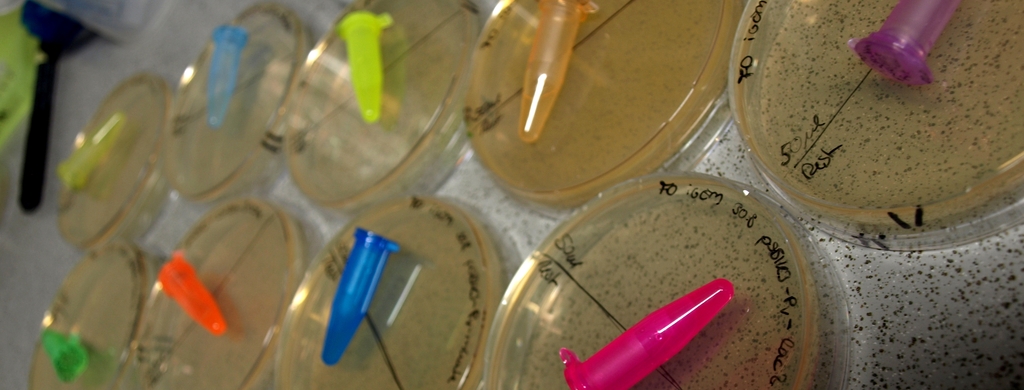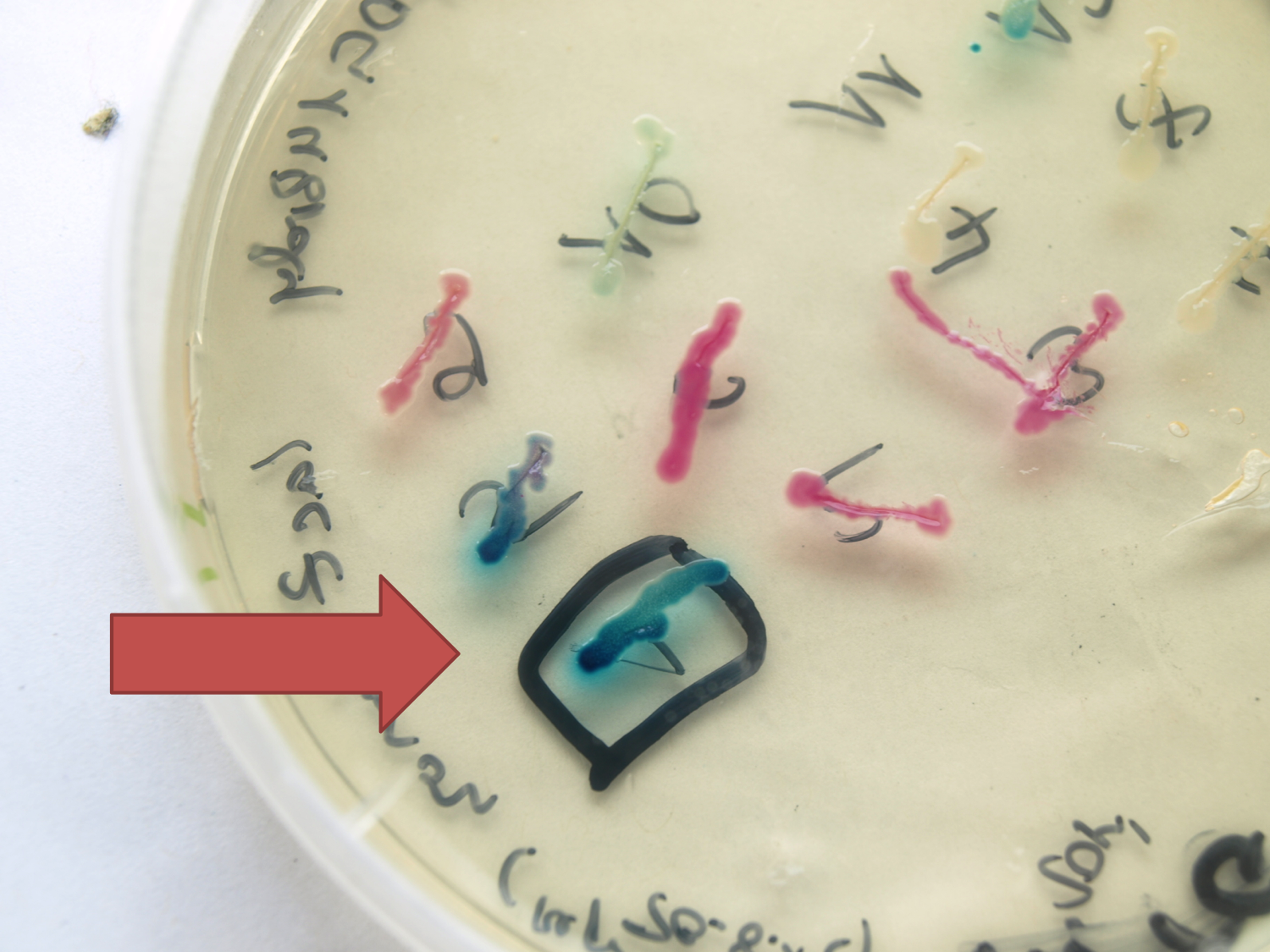Team:LMU-Munich/Bacillus BioBricks
From 2012.igem.org
| Line 307: | Line 307: | ||
*'''3x Flag - tag''' [http://partsregistry.org/Part:BBa_K823034 (BioBrick:BBa_K823034)] | *'''3x Flag - tag''' [http://partsregistry.org/Part:BBa_K823034 (BioBrick:BBa_K823034)] | ||
| - | The Flag-tag was the first epitope tag to be published ([http://www.nature.com/nbt/journal/v6/n10/full/nbt1088-1204.html T.P. Hopp, K.S. Prickett et al. (1988)]). It consists of eight hydrophobic aminoacids: DYKDDDDK and the 3x Flag tag is: DYKDHDGDYKDHDIDYKDDDDK. There are a variety of monoclonal antibodies against this tag, N-terminal as well as position insensitive. | + | The Flag-tag was the first epitope tag to be published ([http://www.nature.com/nbt/journal/v6/n10/full/nbt1088-1204.html T.P. Hopp, K.S. Prickett et al. (1988)]). It consists of eight hydrophobic aminoacids: DYKDDDDK and the 3x Flag tag is: <b>DYKDHDGDYKDHDIDYKDDDDK</b>. There are a variety of monoclonal antibodies against this tag, N-terminal as well as position insensitive. |
*'''HA - tag''' [http://partsregistry.org/Part:BBa_K823035 (BioBrick:BBa_K823035)] | *'''HA - tag''' [http://partsregistry.org/Part:BBa_K823035 (BioBrick:BBa_K823035)] | ||
| - | The HA-tag is an epitope derived from the HA-virus. There was first an antibody against it and then the epitope was characterized ([http://www.ncbi.nlm.nih.gov/pubmed/6204768 Wilson, I.A. et al. (1984)]). It was then furthermore used as an tag for protein purification and recognition ([http://www.ncbi.nlm.nih.gov/pubmed/2455217 Field, J. et al. (1988)]). The aminoacid sequence is: YPYDVPDYA. | + | The HA-tag is an epitope derived from the HA-virus. There was first an antibody against it and then the epitope was characterized ([http://www.ncbi.nlm.nih.gov/pubmed/6204768 Wilson, I.A. et al. (1984)]). It was then furthermore used as an tag for protein purification and recognition ([http://www.ncbi.nlm.nih.gov/pubmed/2455217 Field, J. et al. (1988)]). The aminoacid sequence is: <b>YPYDVPDYA</b>. |
*'''cMyc - tag''' [http://partsregistry.org/Part:BBa_K823036 (BioBrick:BBa_K823036)] | *'''cMyc - tag''' [http://partsregistry.org/Part:BBa_K823036 (BioBrick:BBa_K823036)] | ||
| - | The cMyc-tag is a tag derived from the cMyc gene product. Antibodies were derived from the immunisation with synthetic peptides from the cMyc sequence [http://mcb.asm.org/content/5/12/3610.short Mol. Cell. Biol. 5, 3610-3616]). The aminoacid sequence is EQKLISEEDL. | + | The cMyc-tag is a tag derived from the cMyc gene product. Antibodies were derived from the immunisation with synthetic peptides from the cMyc sequence [http://mcb.asm.org/content/5/12/3610.short Mol. Cell. Biol. 5, 3610-3616]). The aminoacid sequence is <b>EQKLISEEDL</b>. |
*'''His - tag''' [http://partsregistry.org/Part:BBa_K823037 (BioBrick:BBa_K823037)] | *'''His - tag''' [http://partsregistry.org/Part:BBa_K823037 (BioBrick:BBa_K823037)] | ||
| - | The His-tag is a metal chelating peptide ([http://www.nature.com/nbt/journal/v6/n11/full/nbt1188-1321.html Hochuli, E.; Bannwarth, W.; Döbeli, H.; Gentz, R.; Stüber, D. (1988)]) consisting of | + | The His-tag is a metal chelating peptide ([http://www.nature.com/nbt/journal/v6/n11/full/nbt1188-1321.html Hochuli, E.; Bannwarth, W.; Döbeli, H.; Gentz, R.; Stüber, D. (1988)]) consisting of <b>HHHHHH</b>. It can therefore be used for protein purification by metal 2+ (mostly nickel or cobalt) containing columns. There are also antibodies against this tag, or nickel/cobalt containing fluorescent probes can be used for detection. Also a immobilization is possible in nickel/cobalt coated plastikware. |
*'''Strep - tag''' [http://partsregistry.org/Part:BBa_K823038 (BioBrick:BBa_K823038)] | *'''Strep - tag''' [http://partsregistry.org/Part:BBa_K823038 (BioBrick:BBa_K823038)] | ||
| - | The Strep-tag is a mimicry peptide of biotin which binds to Streptavidin ([http://www.sciencedirect.com/science/article/pii/S1050386299000339 Skerra, A. and Schmidt, T.G.M. (1999)). Its sequence is WSHPQFEK. It can be used for protein purification, immobilisation with Streptavidin or Strep-tactin ([http://www.ncbi.nlm.nih.gov/pubmed/9415448 Voss, S. and Skerra, A. (1997 | + | The Strep-tag is a mimicry peptide of biotin which binds to Streptavidin ([http://www.sciencedirect.com/science/article/pii/S1050386299000339 Skerra, A. and Schmidt, T.G.M. (1999)]). Its sequence is <b>WSHPQFEK</b>. It can be used for protein purification, immobilisation with Streptavidin or Strep-tactin ([http://www.ncbi.nlm.nih.gov/pubmed/9415448 Voss, S. and Skerra, A. (1997)]) or detection with Strep-tactin or antibodies. |
Revision as of 11:52, 25 September 2012

The LMU-Munich team is exuberantly happy about the great success at the World Championship Jamboree in Boston. Our project Beadzillus finished 4th and won the prize for the "Best Wiki" (with Slovenia) and "Best New Application Project".
[ more news ]


B4 - 22 core parts for Bacillus subtilis
We will create a toolbox of Bacillus BioBricks to contribute to the registry.
This Bacillus BioBrickBox (B4) contains Bacillus specific parts:
| Vectors | Promoters | Reporters | Affinity tags |

| 
| 
| |
|
pSBBs1C |
Anderson |
gfp |
Flag |
Bacillus Vectors 
We have generated a suit of BioBrick-compatible vectors, three empty ones with different antibiotic resistances and integration loci, two reporter and two expression vectors.Here is a list of all the vectors we cloned and used.
For the use of our vectors, please see our Protocols page. A general introduction to Bacillus subtilis and its integrative vectors can be found here. All vectors have ampicillin as Escherichia coli resistance and RFP in the multiple cloning site as selection marker.
| Vector Name | Resistance | Insertion | Description | Vector origin | ||
|---|---|---|---|---|---|---|
| BioBrick | Eco | Bsu | locus | Name | Reference | |
| pSBBs1C [http://partsregistry.org/wiki/index.php?title=Part:BBa_K823023 (BBa_K823023)] | Amp | Cm | amyE | empty | pDG1662 | [http://www.ncbi.nlm.nih.gov/pubmed/8973347 Guérout-Fleury] |
| pSBBs4S [http://partsregistry.org/wiki/index.php?title=Part:BBa_K823022 (BBa_K823022)] | Amp | Spec | thrC | empty | pDG1731 | [http://www.ncbi.nlm.nih.gov/pubmed/8973347 Guérout-Fleury] |
| pSBBs2E [http://partsregistry.org/wiki/index.php?title=Part:BBa_K823027 (BBa_K823027)] | Amp | MLS | lacA | empty | pAX01 | [http://www.ncbi.nlm.nih.gov/pubmed/11274134 Härtl] |
| pSBBs1C-lacZ [http://partsregistry.org/wiki/index.php?title=Part:BBa_K823021 (BBa_K823021) ] | Amp | Cm | amyE | lacZ reporter | pAC6 | [http://www.ncbi.nlm.nih.gov/pubmed/11902727 Stülke] |
| pSBBs3C-luxABCDE [http://partsregistry.org/wiki/index.php?title=Part:BBa_K823025 (BBa_K823025)] | Amp | Cm | sacA | luxABCDE reporter | pAH328 | [http://www.ncbi.nlm.nih.gov/pubmed/20709900 Schmalisch] |
| pSBBs4S-PXyl [http://partsregistry.org/wiki/index.php?title=Part:BBa_K823024 (BBa_K823024)] | Amp | Spec | thrC | Xylose-promoter | pXT | [http://www.ncbi.nlm.nih.gov/pubmed/11069659 Derré] |
| pSBBs0K-Pspac [http://partsregistry.org/wiki/index.php?title=Part:BBa_K823026 (BBa_K823026)] | Amp | Kan | replicative | IPTG-promoter | pDG148 | [http://www.ncbi.nlm.nih.gov/pubmed/11728721 Joseph] |
| Sporovector [http://partsregistry.org/wiki/index.php?title=Part:BBa_K823054 (BBa_K823054)] | Amp | Spec | thrC | to create Sporobeads | pSBBs4S | Sporovector |
Here you can find the respective vector maps:

| 
|

| 
|

| 
|

| 
|
The number in the vector's name codes for the insertion locus and the following letter for the Bacillus subtilis resistance gene according to the following table:
| Number | Insertion locus | Letter | Resistance |
|---|---|---|---|
| 0 | replicative | C | Chloramphenicol (Cm) |
| 1 | amyE (amylase) | E | MLS (Erythromycin + Lincomycin) |
| 2 | lacA (β-galactosidase) | K | Kanamycin (Kan) |
| 3 | sacA (sucrase) | S | Spectinomycin (Spec) |
| 4 | thrC (threonine synthase) |
The concentrations of the antibiotics and the insertion tests can be found in our Protocol section.
See here to find out how to use B. subtilis vectors. In this overview, the mechanism of integration B. subtilis vectors is described.
The design and special use of our Sporovector can be found here.
For results, check our data page: ![]()
Bacillus Promoters 
To get a set of promoters with different strength we characterized several promoters in Bacillus subtilis. They can be divided in three different groups: the constitutive promoters from the [http://partsregistry.org/Part:BBa_J23100 Anderson collection] from the Partsregistry, the constitutive promoters PliaG, Pveg and PlepA from B. subtilis, and the inducible promoters PliaI and Pxyl-XylR from B. subtilis. For the characterization of the different promoters we used the lux operon ![]() where gene expression leads to the production of luminescence. For this promoter evaluation the reporter vector pSBBs3C-luxABCDE was used which was not fully in BioBrickStandard in this time because of one last forbidden restriction site. We also used the reporter gene lacZ
where gene expression leads to the production of luminescence. For this promoter evaluation the reporter vector pSBBs3C-luxABCDE was used which was not fully in BioBrickStandard in this time because of one last forbidden restriction site. We also used the reporter gene lacZ ![]() for the promoter evaluation where the promoter activity can be measured by doing β-galactosidase assays. Therefore we used the reporter vector pSBBs1C-lacZ. See this page for an overview and background information of all evaluated promoters and see the Data page for more details.
for the promoter evaluation where the promoter activity can be measured by doing β-galactosidase assays. Therefore we used the reporter vector pSBBs1C-lacZ. See this page for an overview and background information of all evaluated promoters and see the Data page for more details.
Overview of several evaluated promoters
Here you can get an overview of the evaluated promoters which cover a large range of activity. For more details and for informations for the experiments see the Data page of the promoters.

Overview of promoter activity measured with luminescence measurements. These values derive from the experiments you can find in our Data section. LUMI per OD600 are taken at a OD600 of 0,1. Curves are the average and the standard deviation of two independent clones. Shown is the activity of the Anderson promoters J23115 (#115), J23106 (#106), J23100 (#100) and J23101 (#101) as well as the activity of the constitutive promoters PliaG and PlepA. The activity of the inducible promoter PliaI is shown with (+bac) and without (-bac) induction with bacitracin (10 μg/ml).
Anderson promoters
The first group of promoters evaluated are the promoters of the [http://partsregistry.org/Part:BBa_J23100 Anderson collection] ("Anderson promoters"). They have already been measured in Escherichia coli where they all showed a constitutive behavior with a different strength. In this project, eleven Anderson promoters were characterized in B. subtilis with the lux operon as a reporter. In this evaluation in B. subtilis they showed quiet a low activity (see Data Anderson promoters ![]() ).
To confirm this result some Anderson promoters were also evaluated with the reporter gene lacZ by doing β-galactosidase assays (see Data Anderson promoters
).
To confirm this result some Anderson promoters were also evaluated with the reporter gene lacZ by doing β-galactosidase assays (see Data Anderson promoters ![]() ).
).
- J23100 ([http://partsregistry.org/wiki/index.php?title=Part:BBa_K823004 BioBrick:BBa_K823004])
- J23101 ([http://partsregistry.org/wiki/index.php?title=Part:BBa_K823005 BioBrick:BBa_K823005])
- J23102 ([http://partsregistry.org/wiki/index.php?title=Part:BBa_K823006 BioBrick:BBa_K823006])
- J23103 ([http://partsregistry.org/wiki/index.php?title=Part:BBa_K823007 BioBrick:BBa_K823007])
- J23106 ([http://partsregistry.org/wiki/index.php?title=Part:BBa_K823008 BioBrick:BBa_K823008])
- J23107 ([http://partsregistry.org/wiki/index.php?title=Part:BBa_K823009 BioBrick:BBa_K823009])
- J23113 ([http://partsregistry.org/wiki/index.php?title=Part:BBa_K823010 BioBrick:BBa_K823010])
- J23114 ([http://partsregistry.org/wiki/index.php?title=Part:BBa_K823011 BioBrick:BBa_K823011])
- J23115 ([http://partsregistry.org/wiki/index.php?title=Part:BBa_K823012 BioBrick:BBa_K823012])
- J23117 ([http://partsregistry.org/wiki/index.php?title=Part:BBa_K823013 BioBrick:BBa_K823013])
- J23118 ([http://partsregistry.org/wiki/index.php?title=Part:BBa_K823014 BioBrick:BBa_K823014])
Constitutive promoters from B. subtilis
The second group of promoters charaterized are the constitutive promoters from B. subtilis. We evaluated the promoters PliaG, Pveg and PlepA. Therefore we used the lux operon as reporter as well as the lacZ gene.
- PliaG ([http://partsregistry.org/wiki/index.php?title=Part:BBa_K823000 BioBrick:BBa_K823000])
PliaG is a weak, constitutive promoter from B. subtilis. It is responsible for the transcription of the last four genes of the liaIHGFSR locus and therefore for the production of the components of the LiaRS system, which is important for the detection of cell wall antibiotics [http://www.ncbi.nlm.nih.gov/pubmed?term=Journal%20of%20Bacteriology%2C%20188%20%2814%29%3A%205153%E2%80%935166: (Jordan et al., 2006)]. PliaG was evaluated with the lux operon as reporter (see Data constitutive promoters ![]() ) and the reporter lacZ (see Data constitutive promoters
) and the reporter lacZ (see Data constitutive promoters ![]() ). This promoter showed a much higher activity than the Anderson promoters which was still weak in comparison to the other evaluated Bacillus promoters.
). This promoter showed a much higher activity than the Anderson promoters which was still weak in comparison to the other evaluated Bacillus promoters.
- Pveg ([http://partsregistry.org/wiki/index.php?title=Part:BBa_K823003 BioBrick:BBa_K823003])
Pveg is known to show a strong constitutive activity during the vegetative growth phase and sporulation phase. This promoter is important for the transcription of the veg gene, which plays an important role during sporulation [http://www.ncbi.nlm.nih.gov/pubmed?term=J.%20Biochem.%2C%20133%20%284%29%3A%20475%E2%80%93483: (Fukushima et al., 2003)]. Pveg was measured by using reporter gene lacZ (see Data constitutive promoters ![]() ). This promoter was the strongest of our evaluated promoters.
). This promoter was the strongest of our evaluated promoters.
- PlepA ([http://partsregistry.org/wiki/index.php?title=Part:BBa_K823002 BioBrick:BBa_K823002])
PlepA is constitutive promoter which is important for the transcription of a bicistronic operon. One of the expressed proteins is the protein PlepA [http://www.ncbi.nlm.nih.gov/pubmed?term=Microbiology%2C%20142%3A%201641%E2%80%931649: (Homuth et al., 1996)]. This protein plays an important role during the translation as it can move the mRNA-tRNA complex one step back in the ribosome which is expected to improve the fidelity of translation [http://www.ncbi.nlm.nih.gov/pubmed?term=Cell%2C%20127%20%284%29%3A%20721%E2%80%93733: (Qin et al., 2006)]. This promoter was evaluated with the lux operon as a reporter (see Data constitutive promoters ![]() ). The activity of this promoter is between the activity of the strongest promoter Pveg and the weak Bacillus promoter PliaG.
). The activity of this promoter is between the activity of the strongest promoter Pveg and the weak Bacillus promoter PliaG.
Inducible promoters from B. subtilis
The last group of promoters consists of two inducible promoters of B. subtilis , PliaI and Pxyl-XylR. They are useful to decide when to turn on gene expression because these promoters need an inducer to start transcription. They are evaluated with the reporters lux and lacZ.
- PliaI ([http://partsregistry.org/wiki/index.php?title=Part:BBa_K823001 BioBrick:BBa_K823001])
PliaI is an inducible promoter from B. subtilis which is induced by antibiotics that interact with the lipidII cycle, e.g. bacitracin. If the cell senses stress there is a phosphorylation of the two proteins LiaS and LiaR. LiaR binds to the operator of the promoter and induces the transcription. When the promoter is turned on the two proteins LiaI and LiaH are expressed which play an important role in the stress response [http://www.ncbi.nlm.nih.gov/pubmed?term=Journal%20of%20Bacteriology%2C%20188%20%2814%29%3A%205153%E2%80%935166: (Jordan et al., 2006)]. This promoter is evaluated with the reporter lux (see Data inducible promoters ![]() ) as well as lacZ (see Data inducible promoters
) as well as lacZ (see Data inducible promoters ![]() ). The induction was measured with different concentrations of bacitracin. With induction with different concentrations of bacitracin this promoter covers a large range of activity.
). The induction was measured with different concentrations of bacitracin. With induction with different concentrations of bacitracin this promoter covers a large range of activity.
- PXyl-XylR ([http://partsregistry.org/wiki/index.php?title=Part:BBa_K8230015 BioBrick:BBa_K823015])
PXyl-XylR is a inducible promoter from B. subtilis which is induced by xylose. XylR is constitutively expressed, and is the repressor of PXyl in absence of the sugar Xylose. In presence of Xylose, XylR leaves the operator and the PXyl is active (see e.g. [http://www.ncbi.nlm.nih.gov/pubmed/2544559 Kreuzer et al.]). For this promoter we have not yet suceeded cloning it in the reporter vector to evaluate the activity. So there is not any data for this promoter yet.
Bacillus Reporters 
We designed some reporters that are commonly used in B. subtilis or are codon optimized versions of popular reporter genes. All reporters have a modified iGEM Freiburg standard ([http://partsregistry.org/Help:Assembly_standard_25 RCF 25]) pre- and suffix for assembly of in-frame fusion proteins. Our prefix also includes the B. subitlis optimized RBS.
prefix: GAATTCCGCGGCCGCTTCTAGATAAGGAGGAACTACTATGGCCGGC
suffix: ACCGGTTAATACTAGTAGCGGCCGCTGCAGT
- GFP ([http://partsregistry.org/wiki/index.php?title=Part:BBa_K823039 BioBrick:BBa_K823039])
We took a gfp derivate of the Bacillus subtilis plasmids pGFPamy and added the BioBrick compatiple pre- and suffix of the Freiburg standard (Assembly 25).
- mKate2 ([http://partsregistry.org/wiki/index.php?title=Part:BBa_K823029 BioBrick:BBa_K823029])
We synthesized this monomeric far-red fluorescence protein with a codon-optimized version for the use in B. subtilis with pre- and suffix of the Freiburg standard. We cloned this reporter in front of the terminator B0014. For the evaluation this reporter was successfully combined with the promoters PliaI, PlepA and the Anderson promoter J23101 in the empty Bacillus vector pSBBs1C from our BacillusBioBrickBox. At the moment we have the right clones of B. subtilis with the integrated construct. Unfortunately we have no equipment to measure this reporter. Neither our plate reader nor the fluorescent microscope has the required filters.
- LacZ ([http://partsregistry.org/wiki/index.php?title=Part:BBa_K823019 BioBrick:BBa_K823019])
This lacZ gene is derived from the Bacillus reporter vector pAC6. It is constructed in the Freiburg Standard (Assembly 25) for in-frame fusion proteins. It also includes a Shine-Dalgarno Sequence optimized for Bacillus subtilis translation. This lacZ BioBrick was tested in the expression vector pSBBs0K-Pspac. This construct showed a high activity, so this BioBrick should work. See Data in the vector evaluation section of pSBBs0K-Pspac.
- luc ([http://partsregistry.org/wiki/index.php?title=Part:BBa_K823028 BioBrick:BBa_K823028])
We synthesized this luciferase for luminescence assays with luciferin as substrate.
Affinity Tags 
All our tags have been synthesized by gene art. They are designed in Freiburg standard with an included optimized ribosome binding site. We have not tested our tags, yet.
prefix: GAATTCCGCGGCCGCTTCTAGATAAGGAGGAACTACTATGGCCGGC
suffix: ACCGGTTAATACTAGTAGCGGCCGCTGCAGT
- 3x Flag - tag [http://partsregistry.org/Part:BBa_K823034 (BioBrick:BBa_K823034)]
The Flag-tag was the first epitope tag to be published ([http://www.nature.com/nbt/journal/v6/n10/full/nbt1088-1204.html T.P. Hopp, K.S. Prickett et al. (1988)]). It consists of eight hydrophobic aminoacids: DYKDDDDK and the 3x Flag tag is: DYKDHDGDYKDHDIDYKDDDDK. There are a variety of monoclonal antibodies against this tag, N-terminal as well as position insensitive.
- HA - tag [http://partsregistry.org/Part:BBa_K823035 (BioBrick:BBa_K823035)]
The HA-tag is an epitope derived from the HA-virus. There was first an antibody against it and then the epitope was characterized ([http://www.ncbi.nlm.nih.gov/pubmed/6204768 Wilson, I.A. et al. (1984)]). It was then furthermore used as an tag for protein purification and recognition ([http://www.ncbi.nlm.nih.gov/pubmed/2455217 Field, J. et al. (1988)]). The aminoacid sequence is: YPYDVPDYA.
- cMyc - tag [http://partsregistry.org/Part:BBa_K823036 (BioBrick:BBa_K823036)]
The cMyc-tag is a tag derived from the cMyc gene product. Antibodies were derived from the immunisation with synthetic peptides from the cMyc sequence [http://mcb.asm.org/content/5/12/3610.short Mol. Cell. Biol. 5, 3610-3616]). The aminoacid sequence is EQKLISEEDL.
- His - tag [http://partsregistry.org/Part:BBa_K823037 (BioBrick:BBa_K823037)]
The His-tag is a metal chelating peptide ([http://www.nature.com/nbt/journal/v6/n11/full/nbt1188-1321.html Hochuli, E.; Bannwarth, W.; Döbeli, H.; Gentz, R.; Stüber, D. (1988)]) consisting of HHHHHH. It can therefore be used for protein purification by metal 2+ (mostly nickel or cobalt) containing columns. There are also antibodies against this tag, or nickel/cobalt containing fluorescent probes can be used for detection. Also a immobilization is possible in nickel/cobalt coated plastikware.
- Strep - tag [http://partsregistry.org/Part:BBa_K823038 (BioBrick:BBa_K823038)]
The Strep-tag is a mimicry peptide of biotin which binds to Streptavidin ([http://www.sciencedirect.com/science/article/pii/S1050386299000339 Skerra, A. and Schmidt, T.G.M. (1999)]). Its sequence is WSHPQFEK. It can be used for protein purification, immobilisation with Streptavidin or Strep-tactin ([http://www.ncbi.nlm.nih.gov/pubmed/9415448 Voss, S. and Skerra, A. (1997)]) or detection with Strep-tactin or antibodies.

| 
| 
| 
|
| Bacillus Intro | Bacillus BioBrickBox | Sporobeads | Germination STOP |
 "
"






